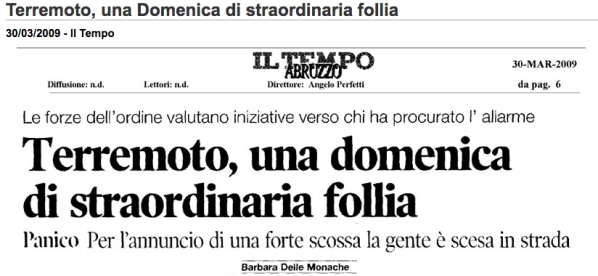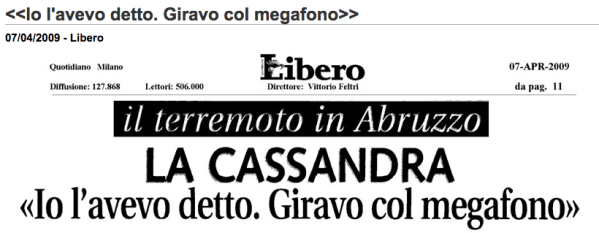Translated by google translate, reviewed
On March 31, 2009, an earthquake expert meeting convened by the Head of Civil Protection, G. Bertolaso, took place in L’Aquila; the consequences of it were the subject of countless discussions, articles, volumes, and a famous trial.
It is not my intention to take up those arguments, which still see a flourishing of interventions, as always not completely updated.
I just want to remember how it came to that meeting.
A sequence of earthquakes had been going on for months in the L’Aquila area, causing fear and insecurity in the population. On the morning of March 29 there was an M3.8 event in the Sulmona area (60 km far away from L’Aquila). Shortly after – as reported by “Il Tempo” on March 30th:

the technician of INAF (National Institute of Astrophysics) G. Giuliani called the Mayor of Sulmona, F. Federico, who was in Rome, announcing “the loading of a seismic swarm that would have resulted in an earthquake of higher intensity than the first”: in Sulmona, evidently, 60 km far away from L’Aquila.
Later, he also called the Civil Protection of Sulmona, the Police Station and the Municipal Police. The Mayor also recalled that affair in an intervention at the tv show “Porta a Porta” after the earthquake (8 April 2009), recently posted by the group of the “M6.5 Project” of Sulmona
https://www.facebook.com/groups/126134850746150/permalink/3112199455472993/
While the Mayor racked his brains in the dilemma about what to do, the news ended up circulating anyway causing panic, aided also by a van announcing the impending earthquake with a megaphone.
It should be remembered that, in the previous weeks, people wearing megaphones were driving around the city of L’Aquila inviting them to leave their homes in anticipation of an imminent destructive earthquake. According to the quotation marks of Libero (7 April 2009) G. Giuliani himself claimed those initiatives

On March 30th the Press Agency ANSA issued the following statement of the Regional Civil Protection:
Object: Civil Protection: no other shocks are foreseen in the Aquila area.
(ANSA) – Pescara, MARCH 30 – In the area of L’Aquila “no other earthquakes of any intensity are foreseen”. This was announced by the permanent [regional] civil protection operations room, highlighting that “all the information disseminated of other content is to be considered false and without any foundation” …
Perhaps the communiqué was intended to state that any prediction was to be considered unfounded, but the text itself could suggest a different reading.
In the press I found no trace of the release itself or any reactions. Only a couple of years later, by means of an interception of a telephone call between G. Bertolaso and the regional Responsible for Civil Protection D. Stati, which was made known only during the trial, we learned that it was precisely that statement to determine, in addition to the obvious resentment of Bertolaso, his decision to organize an expert meeting in L’Aquila, open for local officials.
In the afternoon of the same March 30, an M4.0 earthquake occurred in the L’Aquila area. The Mayor M. Cialente ordered the closure of the schools to carry out checks. Meanwhile, Carabinieri and Police from Sulmona denounced G. Giuliani for procured alarm.
On March 31, late afternoon, the expert meeting took place. It should be emphasized that the media presented the meeting for what it really was, namely a “meeting of experts from the Great Risks Commission (F. Barberi, E. Boschi, GM Calvi, C. Eva)”, which was expected to be attended also by the deputy head of the Civil Protection (B. De Bernardinis), the Civil Protection Regional Responsible D. States and the L’Aquila Mayor M. Cialente. Also other local and national officials, the director of the INGV National Earthquake Center G. Selvaggi, invited by E. Boschi, and some “self-invited” persons attended the meeting.
In current use the denomination of the meeting was simplified in “meeting of the Great Risks Commission (CGR)“; however, if such, its convocation should have followed different and well-defined procedures.
Later, the Public Prosecutor and the Judge of the first instance trial, in the respective trial documents, climbed on the mirrors to show that the meeting itself had to be considered in all respects as a meeting of the Commission, to apply its responsibilities accordingly. This interpretation was forcefully and clearly denied by the Judgment of Appeal, confirmed by the Supreme Court.
The results of the meeting are known and include:
- the (un)famous [glass of wine] tv interview with B. De Bernardinis, released before the meeting itself but later broadcast, and which was therefore considered by many listeners as a summary of the meeting itself. Incidentally, most of the victims’ relatives referred to this interview as a reassuring message, and for this reason B. De Bernardinis was finally sentenced;
- the press conference by F. Barberi, B. De Bernardinis, M. Cialente and D. Stati after the meeting, of which only the video is kept, without audio.
In addition, youtube preserves a video of a declaration of D. Stati released on March 31, before the meeting, which proposes completely correct arguments (except for the reference to the denomination “meeting of the CGR”)
https://www.youtube.com/watch?v=8mienAqeWE8
The minutes of the meeting, long discussed with respect to many scientific, ethical, operational, aspects, had no impact on the behavior of the population as it was released after the earthquake of 6 April.
After the 31 March meeting the Mayor M. Cialente asked the National Government for the declaration of “state of emergency”.
There are no particularly significant traces in the local press regarding the results of the expert meeting and the request of the Mayor in the following days. A detailed analysis of the press can be found in
“Media e traduzione delle conoscenze scientifiche prima del terremoto del 2009” by A. Amato and F. Galadini, in ” Terremoti, comunicazione, diritto “, edited by A. Amato, A. Cerase and F. Galadini, 2015, F. Angeli.
An interesting analysis of how the population lived the period before the earthquake of 6 April 2009, and in particular the last week, can be found in “Sul significato della rassicurazione. L’Aquila una settimana prima del terremoto” (On the meaning of reassurance. L’Aquila one week before the earthquake)”, by V. Valentini
https://news-town.it/cultura-e-societa/5606-sul-significato-della-rassicurazione-l-aquila-una-settimana-prima-del-terremoto.html
unfortunately incomplete online. The reference to the management of schools is interesting, among other things:
“The mayor ordered the closure of all the school buildings, so as to allow the municipality’s technicians to carry out the tests and verify the viability of the structures. Except for a couple, all the other schools, even those where the shocks of the last few weeks had opened small cracks in the walls, detached the skirting boards or pieces of plaster from the walls, were reopened two days later. Our biology professor, too, had given her a positive response: Palazzo Quinzi, the seat of our high school “Domenico Cotugno”, was a structure of proven stability, having in fact brilliantly survived the catastrophic earthquake of 1703.”
Under the same title there are also interesting comments:
https://www.reddit.com/r/italy/comments/2mrjcq/sul_significato_della_rassicurazione_laquila_una/
A few days later, on 6 April, the destructive earthquake occurred.
It is still surprising today to see, in the press and in the videos, the enormous space occupied by the question of the alleged, unheeded predictions of G. Giuliani, against the almost total disinterest in the problem of the vulnerability of collapsed buildings. Moreover, the whole first degree trial was tackled around the problem of missed forecasting, hidden under the guise of the lack or inadequate assessment of seismic risk by the experts. The vulnerability of the buildings was considered an inevitable fact, and the reference to the need for its reduction – made by some of the participants to the meeting – was branded by the judge as “as obvious as it was useless“.
This post, and actually the entire blog, is dedicated to colleagues who, in addition to continuing to do their jobs, from 2010 to 2015 went through three levels of judgment.
For six of them the Court of Appeal ruled that “the fact [of which they were accused] does not exist“, a decision confirmed by the Supreme Court.
Among them Enzo Boschi, who recently passed away.
————————————————————————————————————-
Material for understanding the events related to the so called “L’Aquila” trial, among several others, can be found in:
https://processoaquila.wordpress.com/
https://terremotiegrandirischi.com/
Stucchi, R. Pinho, M. Cocco, 2016. After the L’Aquila Trial. Seismological Research Letters (2016) 87 (3): 591-596. https://doi.org/10.1785/0220150261